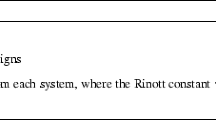Summary
In this study, an alternative estimation strategy is suggested, which requires the solution of a dynamic programming problem, expressed in term of conditional choice value functions. The problem of defining the Euler equation for the corner solution case is overcome by introducing an additional constraint on the conditional choice value functions, which provides a correction for the sample selection bias. The problem of estimating the parameters of the resulting objective function and of the state equation is solved using numerical methods in a linear-quadratic inverse control problem which consists of an objective function together with the set of introduced constraints. First step estimates are computed by generalized maximum entropy estimation techniques.
Similar content being viewed by others
References
Aguirregabiria, V. (1997), Estimation of Dynamic Programming Models with Censored Dependent Variables. Investigaciones Economicas, 21(2), 167–208.
Aguirregabiria, V. (1999), The Dynamics of Markups and Inventories in Retailing Firms. Review of Economic Studies, 66, 275–308.
Aguirregabiria, V. and Mira P. (2002), Swapping the Nested Fixed Point Algorithm: A Class of Estimators for Discrete Markov Decision Models. Econometrica, 70(4), 1519–1543.
Chow G.C. (1993), Optimal control without solving the Bellman equation. Journal of Dynamics and Control, 17, 621–630.
Gelfand A.E., Smith A.F.M. and Lee T.M. (1992), Bayesian analysis of constrained parameter and truncated data problems. Journal of the American Statistical Association, 87, 523–532.
Golan A., Judge G. and Miller D. (1996), Maximum entropy econometrics: robust estimation with limited data, Wiley.
Hansen, L. P., and Singleton K. (1982), Generalized Instrumental Variables Estimation of Nonlinear Rational Expectations Models. Econometrica, 50, 1269–1281.
Hotz, J., and Miller R. A. (1993), Conditional Choice Probabilities and the Estimation of Dynamic Models. Review of Economic Studies, 60, 497–529.
Hotz, J., Sanders S., and Smith J. (1994), A Simulation Estimator for Dynamic Models of Discrete Choice. Review of Economic Studies, 61, 265–290.
Janes E. T. (1957), Information theory and statistical mechanics, Physics review, 106, 620–630.
Kapur J.N. and Kesavan H.K. (1992), Entropy optimization principles with applications, Academic Press, INC.
Kullback J. (1959), Information theory and statistics, Wiley, New York, NY.
Pukelsheim F. (1994), The three Sigma Rule, American Statistician, 48, 88–91.
Keane, M. P., and Wolpin K. I. (1994), The Solution and Estimation of Discrete Choice Dynamic Programming Models by Simulation and Interpolation: Monte Carlo Evidence. The Review of Economics and Statistics, 76, 648–672.
Kwan, Y. K. and Chow G. C. (1997), Chow’s Method of Optimal Control: A Numerical Solution. Journal of Dynamics and Control, 21, 739–752.
Manski, C. (1988), Path Utility Analysis of Dynamic Choice. SSRI working paper 8805 University of Wisconsin, Madison.
Miller, R. (1984), Job Matching and Occupational Choice. Journal of Political Economy, 92, 1086–1120.
Pakes, A. (1994), Dynamic Structural Models: Problems and Prospects. Mixed Continuous-Discrete Controls and Market Interactions, in Advances in Econometrics: Sixth World Congress by CA. Sims, Ed., Cambridge University Press, Vol. II, 171–259.
Rust, J. (1987), Optimal Replacement of GMC Bus Engines: an Empirical Model of Arold Zurcher, Econometrica, 55, 999–1035.
Rust, J. (1988), Maximum Likelihood Estimation of Discrete Control Processes. SIAM Journal of Control and Optimization, 1006–1024.
Rust, J. (1994), Estimation of Dynamic Structural Models, problems and prospects: Discrete Decision Processes, in Advances in Econometrics: Sixth World Congress by C.A. Sims, Ed., Cambridge University Press, Vol. II, 119–170.
Wolpin, K. I. (1992), An Estimable Dynamic Stochastic Model of Fertility and Child Mortality, Journal of Political Economy, 92, 852–874.
Author information
Authors and Affiliations
Rights and permissions
About this article
Cite this article
Papalia, R.B. Generalized Maximum Entropy Estimation of Dynamic Programming Models with Sample Selection Bias. Computational Statistics 18, 463–475 (2003). https://doi.org/10.1007/BF03354610
Published:
Issue Date:
DOI: https://doi.org/10.1007/BF03354610




